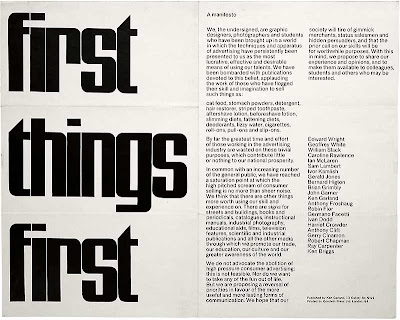
The Futurist Manifesto by F.T. Marinetti published in Le Figaro in 1909, and translated here. See a centenial exhibition on Futurism at The Estorick now until 19th April.



Marinetti's Futurist publications including Zang Tumb Tumb, displaying his sound/concrete poetry using Parole in Liberta (words in freedom) or expressive typography

Dada publication Merz, designed by Kurt Schwitters and El Lissitzky


Anarchist Manifesto

Dada publication which sought to illustrate its ideals of Dadaism in the unconventional layout and use of type. The Dada movement featured mostly the visual arts and graphic design, but also poetry, experimental sound and music, art manifestos, art theory, literature, theatre/performance (see Cabaret Voltaire). It had a strong anti-war stance and used anarchistic expression visually, sonically, and in its use of language, to grab attention. See more details about the Dadaist movement here, and the dada publications (with great closeup scans) here in the Digital Dada Library. When you look at them note the use of collage and photomontage and simple reproduction methods. These techniques might inform how you produce your manifestos.

Dada Manifesto poster

Vorticism Manifesto publication Blast. Vorticism was a british movement closely related to Futurism in its embrace of dynamism, the machine age and all things modern. Blast was cited as a revolutionary influence over Graphic Design by El Lissitsky (more about him later).

Punk Zines. See also Jamie Reid

Statements made to launch the beliefs and aims behind De Stijl (The Style) by painter, theorist and designer Theo van Doesburg and other principal members like painters Piet Mondrian, Vilmos Huszàr, Bart van der Leck, and designers/architects Gerrit Rietveld , Robert van 't Hoff and J.J.P. Oud. In their work and the manifesto they "sought to express a new utopian ideal of spiritual harmony and order. They advocated pure abstraction and universality by a reduction to the essentials of form and colour; they simplified visual compositions to the vertical and horizontal directions, and used only primary colors along with black and white". http://en.wikipedia.org/wiki/De_Stijl
The band The White Stripes used their manifesto to inform their work and presentation of themselves in life, videos, on stage and in artwork related to the band.

Fluxus were an informal international collective of avant-garde artists working across many disciplines (public concerts/festivals, unconventionally designed publications, electronic music scores, theatrical performances, ephemeral events) from the early 1960s to the late 1970s. Their work included distribution of editioned objects, correspondence art and concrete poetry, and audience/recipient participation. Its members, including Joseph Beuys, John Cage, Yves Klein, and Ray Johnson (click to see details of current exhibition of his work) opposed artistic fomality, tradition and professionalism, and they aimed to change the focus from what an artist makes to the artist's personality, actions, and opinions. They caused a lot of controversy at the time.

The Freemasonry Manifesto

Ken Garland's Manifesto for more purposeful, informative, educational and socially and culturally aware design.
Generally see a wiki-compendium on Art Manifestos here and then research them further

A certification of a film adhering to the doctrines of Dogme 95, Lars von Trier and Thomas Vinterberg's manifesto for low budget, lo-fi, gimmick-free, handheld film making.

No comments:
Post a Comment